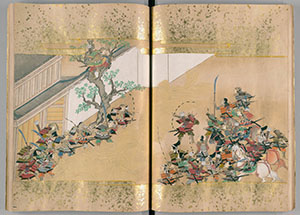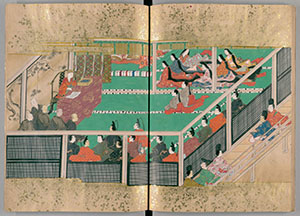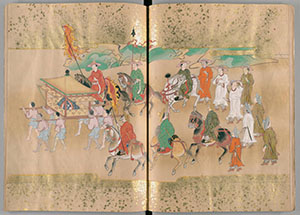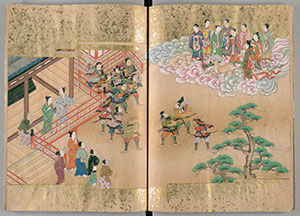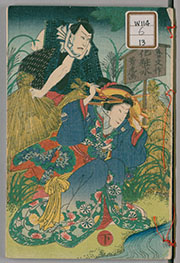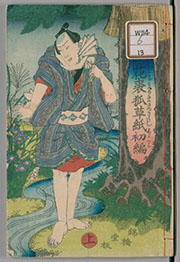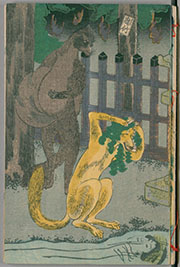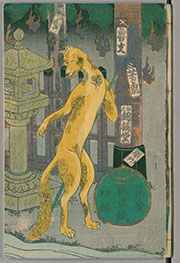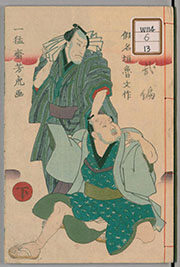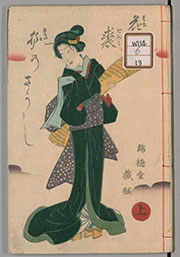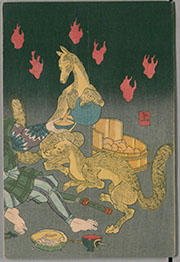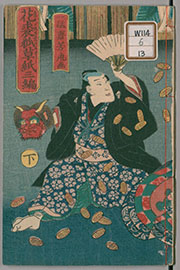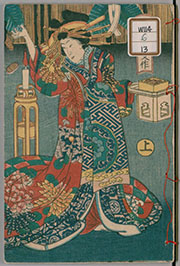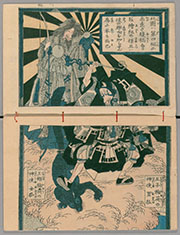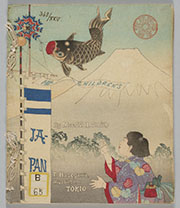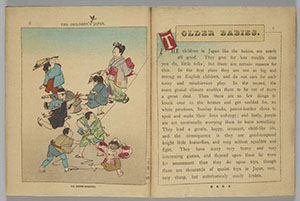70th Anniversary Commemorative Exhibit "A Treasure Box of Books - The 70-year History of the National Diet Library and Its Collections"
- A Treasure Box of Books
- Part 2 Diverse Collections
- Chapter 1 Beautiful Books and Rare Books
- Section 2 Beautiful Japanese Books
Part 2 Chapter 1 Section 2 Beautiful Japanese Books
There are also many beautiful Japanese books. The library exhibition includes manuscripts of colorful Nara-ehon ("Nara picture books", illustrated color manuscripts produced from around the end of the Muromachi Period until the early Edo Period) owned by daimyo (feudal lords) and kuge (court nobles) featuring beautiful paper materials and penmanship. The exhibit also includes elaborate ebira (illustrated bills) produced for common people, as well as chirimenbon (books made of finely wrinkled traditional Japanese paper) produced for non-Japanese.
38 Taishi denki (Legend of Prince Shotoku), copied in the early Edo Period [WA32-21]
Volume 2, Volume 4, Volume 5, Volume 8
An illustrated Nara-ehon (Nara picture book) depicting the life of Prince Shotoku. It includes a total of 47 illustrations. Small-cut gold leaf is sprinkled in the misty areas above and below the illustrations, and the manuscript is produced colorfully and elaborately.
- Volume 2
- The displayed section is a scene of Prince Shotoku at age 16 during the Soga–Mononobe conflict. The illustration shows an army commanded by the prince fighting the army of Mononobe no Moriya. Mononobe no Moriya is the individual shown firing an arrow from up in the tree.
Digital Collections
- Volume 4
- The displayed section shows Prince Shotoku at age 35 being instructed in the Shomangyo, one of the Buddhist scriptures, by Empress Suiko.
Digital Collections
- Volume 5
- The displayed section shows messengers from Zui Dynasty China entering Ikaruga when Prince Shotoku was around age 37.
Digital Collections
- Volume 8
- The displayed section shows tennin (heavenly beings) and tennyo (heavenly maidens) coming for the family of Prince Yamashiro, the son of Prince Shotoku, after the death of Prince Shotoku.
Digital Collections
39 Genji monogatari (The Tale of Genji) by Murasaki Shikibu, copied in the early Edo Period [WA21-26]
Volume 4 Yugao, Volume 3 Utsusemi, Volume 1 Kiritsubo, Volume 5 Wakamurasaki
This work contains each volume of the Genji monogatari (The Tale of Genji) as separate books which have daisen (slips of paper bearing the title) affixed to the centers of the covers displaying the title of each volume. The main text uses writing paper decorated with tortoiseshell, checkerboard patterns, marbling print, or plants and mist drawn in gold or silver paint. It is said to have once been owned by the family of Prince Higashikuni.
40 Hanagoromo kitsune no soshi Volume 3 Chapter 12 by KANAGAKI Robun, illustrated by ICHIMOSAI Yoshitora, Kinkyodo Yamada-ya Shojiro, 1862 [W114-13]
Volume 1, Volume 2, Volume 3
This is a gokan book (an Edo Period illustrated book) produced for the general public. The book tells the story of a romantic drama between an anthropomorphized fox and tanuki (Japanese raccoon dog). The hero Konzaburo is illustrated to look like Nakamura Shikan IV, and the heroine Tamagaki to look like Sawamura Tanosuke III.
- Volume 1
- The displayed sections are the covers of part 1 and part 2 of volume 1. The cover features a gimmick known as a fold-up picture where it can be folded over lengthwise to replace the depicted human characters with the fox and tanuki (raccoon dog) versions.
Digital Collections
- Volume 2
- The displayed sections are the covers of part 1 and part 2 of volume 2. The cover features a gimmick known as a fold-up picture where it can be folded over lengthwise to replace the cover illustration with a different illustration.
Digital Collections
- Volume 3
- The displayed sections are the covers of part 1 and part 2 of volume 3. The cover features a prostitute and her customer while the inside of the covers shows the silhouettes of the same scene with the fox instead.
Digital Collections
- Volume 3
- The displayed sections are the back of leaf 1 to the front of leaf 2, and the back of leaf 2 to the front of leaf 3 of volume 3, all of which are connected in a 4-page-long illustration.
Digital Collections
41 Shomeiryu birashu by BAISOTEI Gengyo, 1884 [WA22-3]
4th quire, 5th quire, 6th quire
This is a collection of kobira (small bills) (302 items) sent to and collected by Baiso Gengyo, who worked in transcription, loved kyoka (a comic variant of the 31-syllable waka poems), and was known as a "master of bill drawing". The senders included painters, rakugo performers, kabuki actors, and more, showing the wide scope of Gengyo's social circles.
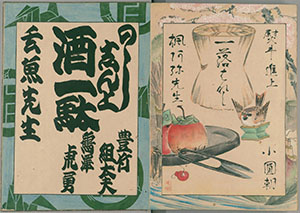
- 4th booklet
- The displayed sections are kobira (small bills) sent from rakugo performer San'yutei Koencho I on the right and from performers of gidayu Toyotake Kumitayu and Tsurusawa Koyu on the left.
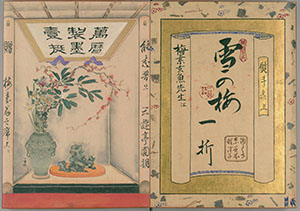
- 5th booklet
- The displayed sections are kobira (small bills) sent from an individual named Asakusanamiki Ritsushi on the right and from rakugo performer of San'yutei Encho I on the left.
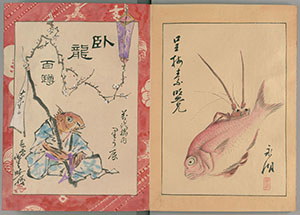
- 6th booklet
- The displayed sections are kobira (small bills) sent from Satake Eiko, who served as official painter for the Ministry of Imperial Household, on the right and from Riutatsu in Bandaibashinai (details unknown) on the left.
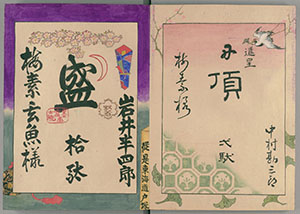
- 6th booklet
- The displayed sections are kobira (small bills) sent from kabuki performer Nakamura Kanzaburo XIII on the right and from kabuki performer Iwai Hanshiro VIII on the left.
- The hand-drawn ebira trend
-
Ebira are illustrated handbills. The vast majority of extant examples were printed. From around 1873 to 1897, it became a trend to send hand-drawn (hand-written) ebira featuring greetings called noshi shinjo along with the names of the gifts being given, the giver's name, and other information when opening a shop, holding shogakai (meetings for extemporary painting and writing) and on other occasions. This ebira later came to be called shinjo bira (submission bills) and iwai bira (celebration bills), however small versions made from iyo masagami (washi, traditional Japanese paper, made in Iyo or Ehime) cut in half were called kobira (small bills), and became a collectible which fashionable individuals competed against each other to obtain.
42 The Children's Japan by Mrs. W. H. Smith, T. Hasegawa, 1892 [B-65]
A chirimenbon printed by Hasegawa Takejiro. The author, Mrs. W. H. Smith, writes on a variety of themes about the daily lives of Japanese children as well as the traditional Japanese lifestyle which formed the basis of their lives. The illustrations of children are very vibrant and lively, and the composition skillfully connects the illustrations with the main text.
